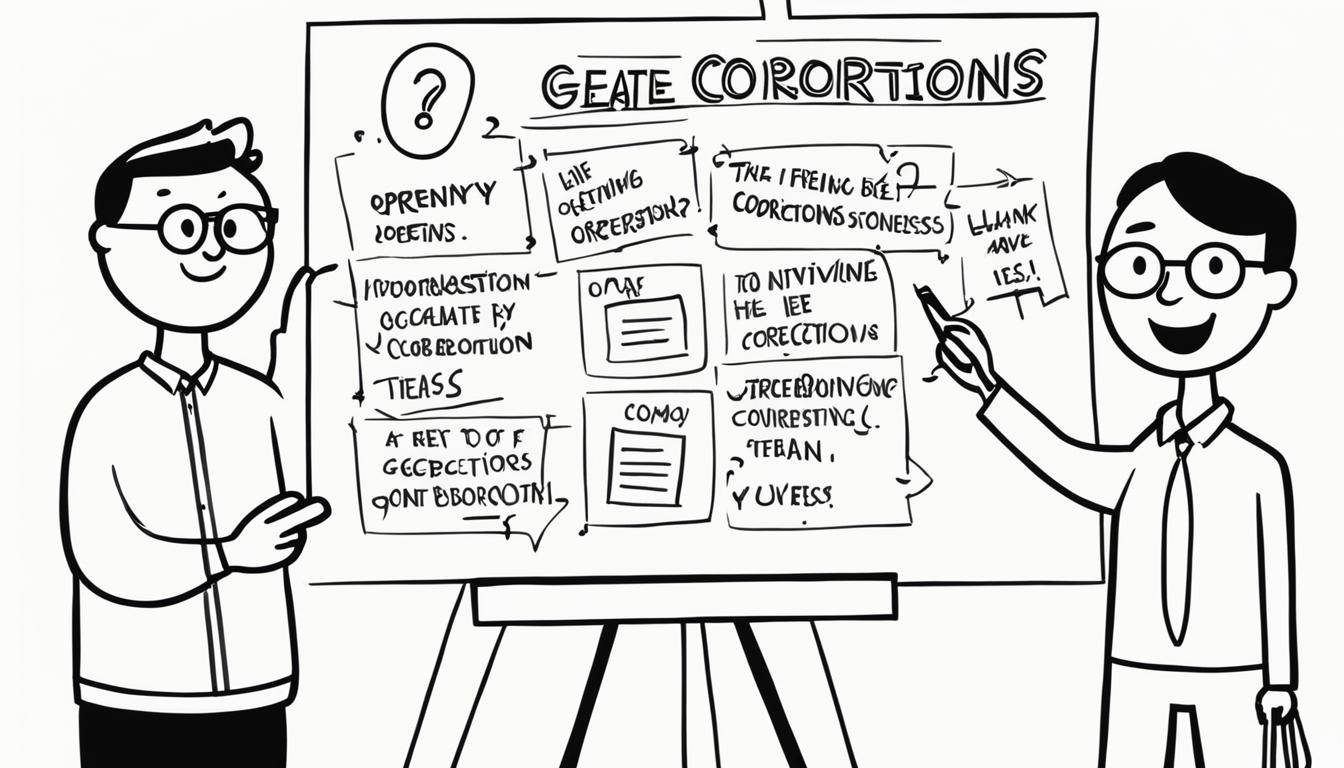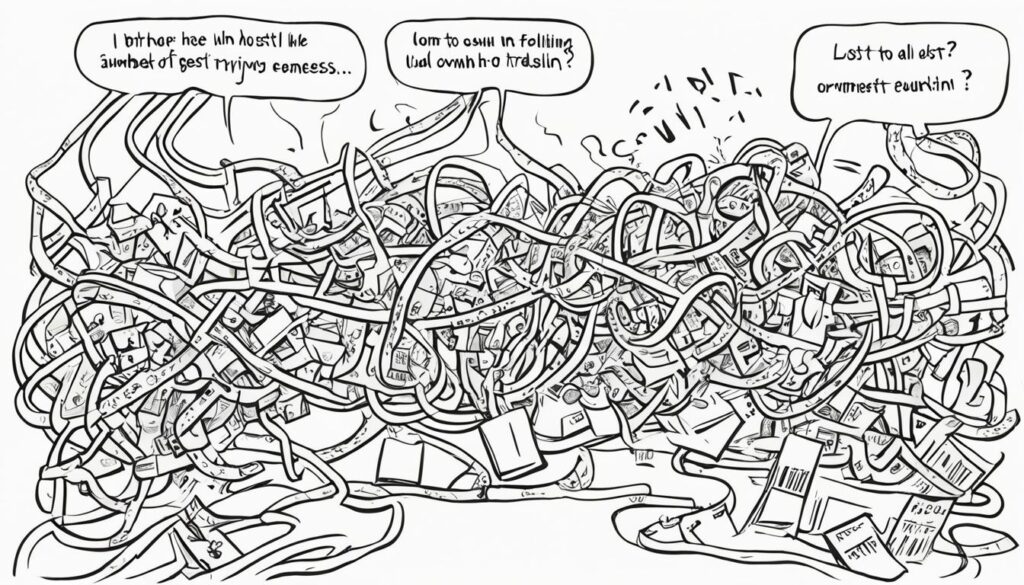In the world of professional email communication, there are moments when we find ourselves unsure about the accuracy of our statements. In these situations, it is essential to convey our willingness to learn and be corrected without compromising the polite and respectful tone. Instead of using the commonly used phrase “please correct me if I am wrong,” there are several alternative phrases that can serve the same purpose while adding variety and uniqueness to our conversations.
By exploring polite alternatives to the phrase “please correct me if I am wrong,” we not only show our openness to correction but also emphasize our commitment to personal growth and continuous improvement. These alternative phrases can be seamlessly integrated into various formal contexts, allowing us to maintain a professional tone while fostering positive and constructive communication.
Key Takeaways
- Using a variety of polite alternatives in professional emails conveys openness to correction and willingness to learn.
- Alternative phrases should be tailored to the specific context to maintain a respectful and professional tone.
- “Please correct me if I misstated anything” provides a useful alternative for seeking accuracy and ensuring information correctness in business emails.
- “Correct me if I’ve misunderstood” shows a sense of responsibility for potential misunderstandings and is suitable for clarifying information in professional emails.
- “Please let me know if I misunderstood” is an effective way to seek confirmation and avoid misinterpretation, especially when communicating after meetings.
Is It Polite to Say “Please Correct Me if I Am Wrong”?
Saying “please correct me if I am wrong” in a professional email is considered polite. It shows that you are open to changing your opinion and willing to learn from your mistakes. This phrase is commonly used in formal contexts to indicate that you are unsure about the accuracy of your statement and would appreciate clarification or correction from the recipient.
“Please correct me if I am wrong” is a humble and respectful phrase that invites others to offer their expertise and point out any errors or misunderstandings. By acknowledging the possibility of being incorrect, you demonstrate your willingness to grow and improve, fostering a collaborative environment rooted in open communication. Employing this polite phrase in professional emails highlights your humility and respect for others’ knowledge.
Politeness in Professional Communication
Politeness is a vital aspect of professional communication. It not only helps maintain respectful relationships but also establishes a positive tone that encourages cooperation and effective collaboration. Using “please correct me if I am wrong” demonstrates your commitment to accuracy, continuous learning, and the pursuit of excellence in your work. Embracing politeness in your emails and other professional interactions reflects well on your character and sets the stage for successful and harmonious working relationships.
- Be Open to Feedback: When you express that you are open to correction, you show that you value the expertise and insights of others. This humility fosters an environment where people feel comfortable sharing their knowledge, ultimately benefiting the entire team or organization.
- Embrace a Growth Mindset: By inviting others to correct you, you exhibit a growth mindset—a belief that skills and abilities can be developed through dedication and hard work. Embracing this mindset promotes continuous improvement and personal growth, enabling you to become more proficient in your field.
- Promote Effective Communication: Using polite phrases like “please correct me if I am wrong” encourages clear and open communication. It helps clarify any misunderstandings, resolves conflicts, and maintains a productive and harmonious working environment.
Overall, incorporating politeness into your professional emails, including the use of the phrase “please correct me if I am wrong”, showcases your respect for others’ knowledge, fosters collaborative relationships, and promotes growth and success within your professional endeavors.
| Pros | Cons |
|---|---|
| Signals openness and willingness to learn | May indicate a lack of confidence |
| Encourages a collaborative working environment | May work better in spoken situations than written ones |
| Establishes respectful and positive relationships |
Pros and Cons of Using “Please Correct Me if I Am Wrong”
While venturing into the realm of professional contexts, the phrase “please correct me if I am wrong” comes with its own set of pros and cons. As I confidently navigate through the nuanced landscape of spoken situations and confident phrases, it is crucial to evaluate the benefits and drawbacks of this commonly used expression.
The pros of using “please correct me if I am wrong” in professional settings are evident. This polite and considerate phrase demonstrates humility and a willingness to learn from others’ perspectives. By acknowledging the potential for error, it creates an atmosphere of open-mindedness and collaboration, fostering positive professional relationships.
“‘Please correct me if I am wrong’ showcases a genuine desire to seek knowledge and improve oneself.”
However, it’s essential to recognize the cons associated with this phrase. One drawback is the inherent lack of confidence it conveys. By prefacing statements with the notion of potential error, one might unintentionally undermine their own credibility or diminish the impact of their message.
“The phrase ‘please correct me if I am wrong’ can inadvertently undermine one’s confidence and authority.”
Furthermore, this phrase tends to work better in spoken situations rather than written ones. Its conversational tone and interpersonal nature may not translate as effectively in written communication, where tone and intent can be easily misinterpreted. In professional writing, it’s crucial to strike the right balance between maintaining a humble and receptive attitude while exhibiting confidence and clarity in one’s statements.
To summarize, the use of “please correct me if I am wrong” in professional contexts comes with both advantages and disadvantages. While it showcases politeness and a willingness to learn, it can also undermine one’s confidence and may not be as suitable for written communication. Understanding the pros and cons empowers us to make informed choices when employing alternative phrases that exude professionalism and clarity in any given situation.
Alternative Ways to Say “Please Correct Me if I Am Wrong”
If you’re looking to add some flair and originality to your professional emails, there are numerous alternative phrases you can use instead of the common “please correct me if I am wrong.” These phrases not only convey the same sentiment but also inject a touch of uniqueness into your communication. They are particularly suitable for maintaining a professional tone in formal writing.
1. Am I mistaken in my understanding?
If you’re unsure about the accuracy of your statement, a polite way to seek correction is by asking, “Am I mistaken in my understanding?” This phrase demonstrates your openness to being corrected and shows respect for the recipient’s knowledge.
2. Could you clarify if I’ve misinterpreted?
For situations where you suspect a misinterpretation, you can use the phrase, “Could you clarify if I’ve misinterpreted?” This conveys a desire for clarification without assuming fault, facilitating open and honest communication.
“Am I mistaken in my understanding?”
3. Let me know if I’m off base.
If you suspect you might be off base or missing crucial information, you can politely request feedback with the phrase, “Let me know if I’m off base.” This approach invites the recipient to provide guidance and ensures accuracy in your communication.
4. If I’m incorrect, please inform me.
To maintain a formal and concise tone, consider using the straightforward phrase, “If I’m incorrect, please inform me.” This simple yet polite request demonstrates your commitment to accuracy and your openness to correction.
“Could you clarify if I’ve misinterpreted?”
By using these alternative phrases, you can add depth and variety to your professional communications. They enable you to maintain a respectful and professional tone while inviting correction and fostering a culture of collaboration.
Now that you’re equipped with alternative ways to seek correction, it’s time to elevate your professional emails and engage in meaningful and effective communication.
Please Correct Me if I Misstated Anything
“Please correct me if I misstated anything” is a humble plea that reflects my desire to ensure accuracy and correctness in my professional email correspondence. In the fast-paced world of business, it is crucial to provide reliable information and avoid any potential misunderstandings or misinterpretations. By using this phrase, I am extending an invitation to the recipient to review my email and point out any inaccuracies or errors they may come across. This simple yet powerful phrase emphasizes the importance I place on delivering precise and reliable information in my business communications.
As professionals, we are constantly faced with the challenge of relaying complex information accurately and concisely. It is easy to unintentionally misstate facts or make errors when conveying intricate details or data. By encouraging the recipient to correct me if I misstated anything, I am demonstrating my commitment to the accuracy and integrity of the information I am sharing. I understand the value of receiving feedback and corrections, as they help me improve and refine my communication with others.
“The art of communication is the language of leadership.” – James Humes
When crafting a business email, I strive to be as thorough and meticulous as possible. However, I acknowledge that perfection is elusive and mistakes can happen. By incorporating the phrase “Please correct me if I misstated anything,” I am actively seeking the assistance of the recipient in identifying any misinformation that may have inadvertently slipped into my message. This demonstrates my willingness to learn and collaborate in order to achieve the highest level of accuracy and professionalism in our communication.
Communication is a two-way street, and by asking for clarification and corrections, I foster an environment of open dialogue and mutual respect. I invite the recipient to be an active participant in the exchange, encouraging them to share their expertise and insights. This not only enhances the quality and reliability of the information shared but also strengthens the professional relationship between us.
Benefits of Using “Please Correct Me if I Misstated Anything”
- **Promotes Accuracy**: By explicitly inviting corrections, this phrase promotes accuracy in professional email communication.
- **Fosters Collaboration**: It creates an environment of openness and collaboration where all parties are encouraged to contribute their knowledge and expertise.
- **Builds Trust and Credibility**: Demonstrating a willingness to be corrected builds trust and credibility with colleagues and business partners.
- **Encourages Continuous Learning**: The phrase reflects a growth mindset, encouraging continuous learning and improvement in professional communication.
Correct Me If I’ve Misunderstood
Correct me if I’ve misunderstood is an elegant way to phrase the request for correction, demonstrating willingness to take responsibility for any misunderstandings. In the realm of professional emails, where clarity and accuracy are paramount, using this phrase allows you to seek clarification and ensure that you have not misinterpreted any information.
When faced with a situation that seems ambiguous or open to interpretation, it is natural to have doubts. By using correct me if I’ve misunderstood in your email, you are not only displaying humility but also acknowledging that you are the one who needs assistance in understanding the situation better.
Seeking clarification is not a sign of weakness, but rather a testament to one’s commitment to accuracy and understanding. By taking the initiative to request correction, you demonstrate a genuine desire to learn and grow.
In a professional context, misunderstandings can have far-reaching consequences. By using the phrase correct me if I’ve misunderstood, you actively take responsibility for clarifying any potential misinterpretations. This demonstrates your professionalism, as it shows that you prioritize accurate communication and value the input and expertise of others.
Furthermore, incorporating correct me if I’ve misunderstood into your email can facilitate productive discussions. It invites your recipient to provide their insights and perspective, which can lead to a more comprehensive understanding of the situation. This phrase creates an atmosphere of openness and collaboration, fostering effective communication within professional relationships.
| Advantages | Considerations |
|---|---|
| Emphasizes personal accountability | Lack of confidence in one’s own understanding |
| Strengthens professional relationships through open dialogue | Works better in written communication rather than verbal exchanges |
| Encourages accurate communication and mutual learning | May be perceived as overly self-deprecating |
Correct me if I’ve misunderstood creates an opportunity for mutual growth and understanding. It signifies your commitment to accuracy while fostering collaborative relationships in professional settings. By using this phrase, you demonstrate humility, take responsibility for clear communication, and invite the expertise of others.
Please Let Me Know If I Misunderstood
Oh, the delicate dance of understanding,
Where thoughts and meanings intertwine.
But what if I miss the mark, my friends?
What if my grasp fails to align?
In the realm of professional email,
Where clarity and accuracy reside,
A simple phrase can bridge the gap,
And restore knowledge with humble stride.
“Please let me know if I misunderstood,”
An earnest request, sincere and true.
For after a meeting, when thoughts collide,
It ensures our understanding stays in view.
When the discourse concludes,
And I reflect on conversations past,
I reach out to my colleagues, seeking clarity,
To ensure my comprehension will last.
A meeting of minds, a symphony of thoughts,
Together we navigate the uncharted sea.
With this plea, I admit my fallibility,
Inviting correction from those wiser than me.
For in the exchange of knowledge and insight,
Misunderstandings are bound to occur.
But with grace and humility, we grow,
Strengthening our professional allure.
So let me know, dear colleagues, I implore,
If my understanding veered off track.
Let’s align our thoughts and bridge the gap,
As we navigate the professional stack.
In the realm of emails, where words are sent,
And conversations blossom like a poetic verse.
“Please let me know if I misunderstood,”
A phrase that helps us navigate and converse.
Please Let Me Know If I Misunderstood: Pros and Cons
In the realm of professional communication,
As we navigate the delicate terrain.
“Please let me know if I misunderstood,”
Has its pros and cons, like the ebb and flow of the rain.
- PRO: Openness to correction, a humble stance.
- CON: A hint of uncertainty, a lack of confidence.
- PRO: Clarity of intentions, a shared understanding.
- CON: A reliance on others, a weakened commanding.
- PRO: Encourages collaboration, a fruitful exchange.
- CON: Potential discomfort, a vulnerability range.
So weigh the options, dear reader mine,
Choose the phrase that resonates with you.
“Please let me know if I misunderstood,”
Or an alternative that feels just as true.
For in the realm of professional email,
Where connections are strengthened and minds align.
The choice is yours, dear friend of words,
To craft messages that intertwine.
Please Tell Me If I’m Wrong
In the realm of professional emails, it is essential to maintain a friendly and approachable tone while conveying your trust in the expertise of your colleagues. To achieve this, you can choose to use the phrase “please tell me if I’m wrong.” This alternative adds a touch of casualness to your email exchanges, making them more relatable and fostering a friendly atmosphere. By using this phrase, you show that you genuinely value their knowledge and insight, inviting them to correct any mistakes or offer their perspective.
When engaging in friendly emails with colleagues whom you have established a good relationship with, “please tell me if I’m wrong” can be a powerful tool. It conveys your trust in their expertise and creates a safe space for open communication. By welcoming their input and corrections, you demonstrate your willingness to learn and grow together. This phrase works particularly well when seeking their guidance on a specific topic or asking for their opinions.
“Please tell me if I’m wrong: I value your expertise and would greatly appreciate your insights on this matter.”
Emphasizing the importance of trust and collaboration, “please tell me if I’m wrong” encourages your colleagues to share their knowledge and correct any potential errors. This phrase fosters an environment where everyone feels comfortable expressing their opinions and contributing to the collective intelligence of the team. It allows for open discussions and promotes a culture of continuous improvement.
“Please tell me if I’m wrong: Your expertise is invaluable, and I trust your judgment. Your input would help ensure the accuracy of our shared knowledge.”
By incorporating “please tell me if I’m wrong” into your friendly emails, you demonstrate humility and acknowledge the fallibility of human knowledge. This phrase allows you to build stronger relationships with your colleagues, creating a supportive community where everyone feels comfortable sharing their thoughts and expertise. It cultivates an environment of trust, fostering collaboration and facilitating the exchange of ideas.
“Please tell me if I’m wrong: I rely on your expertise to keep me on the right track. Together, we can navigate any challenges and achieve great outcomes.”
| Pros | Cons |
|---|---|
| Establishes a friendly and approachable tone | May not be suitable for formal or authoritative emails |
| Demonstrates trust in colleagues’ knowledge | May undermine your confidence in certain situations |
| Encourages open communication and collaboration | Does not convey strong assertiveness |
Let Me Know If I’m Wrong
In the realm of professional email communication, it is crucial to ensure clarity and accuracy, especially when dealing with work problems that require prompt attention. To convey openness to feedback, confirmation-minded individuals often employ the phrase “Let me know if I’m wrong” in their written correspondence.
By utilizing this concise and effective expression, you are inviting your colleagues to provide valuable insights and correct any potential misunderstandings, thus promoting a collaborative environment. It shows that you value their input and are dedicated to finding the best solution.
This phrase is particularly suitable when you encounter a work problem that requires clarification before taking any action. It allows you to seek confirmation, gather additional information, and rectify any potential errors in your understanding. By embracing the possibility of being wrong, you exhibit humility and a growth mindset, setting the stage for constructive collaboration.
In a professional setting, it is ideal to confirm your comprehension of the problem before proceeding with a course of action. When you reach out with the phrase “Let me know if I’m wrong,” you demonstrate your commitment to accuracy and a desire to avoid potential pitfalls that could arise from misinterpretation or miscommunication.
Benefits of Asking for Confirmation
By seeking confirmation before acting, you establish a strong foundation of trust and ensure that everyone involved is on the same page. The benefits of employing this approach include:
- Fostering a collaborative atmosphere
- Promoting open communication and knowledge-sharing
- Avoiding potential mistakes or missteps
- Enhancing problem-solving abilities through collective insights
When you prioritize seeking confirmation, you demonstrate professionalism, dedication, and a commitment to delivering the best possible work. It creates an environment where individuals feel comfortable expressing their thoughts, seeking clarification when needed, and contributing to the collective success of the team.
| Advantages | Considerations |
|---|---|
| Encourages collaboration and teamwork | May require additional time for clarification |
| Demonstrates humility and eagerness to learn | Requires effective communication skills to convey intention |
| Avoids potential errors caused by misunderstandings | Relies on colleagues’ availability and responsiveness |
Am I Wrong in Saying?
Starting an email with “Am I wrong in saying?” is a poetic way to seek validation and confirmation from your colleagues. It shows that I am unsure about the correctness of my statement and am seeking their input. This approach demonstrates humility and a willingness to consider alternative perspectives. It works particularly well when emailing close colleagues whom I trust and value their judgment.
“Am I wrong in saying that we should prioritize sustainability in our business practices? I would appreciate your thoughts on this matter.”
By using this phrase in a professional email, I not only seek validation but also create an open space for dialogue and collaboration. It allows me to express my uncertainties while encouraging others to provide their insights and perspectives. This not only strengthens the professional relationship and fosters a sense of trust but also ensures that the information and ideas shared are accurate and reliable.
Seeking Validation and Encouraging Dialogue
In a fast-paced professional environment, it is not uncommon to have doubts or uncertainties about various topics. Starting an email with “Am I wrong in saying?” provides an opportunity to seek validation, prompt constructive feedback, and encourage dialogue. By taking this approach, I create a safe and supportive environment that values open communication and collaborative problem-solving.
When using this phrase, it is crucial to remain open-minded and receptive to different perspectives. It is essential to listen to the feedback and opinions of others without defensiveness or judgment. By embracing diverse viewpoints, I can refine my ideas, broaden my understanding, and make informed decisions.
- Am I wrong in saying that we should explore new marketing strategies?
- Am I wrong in saying that our team could benefit from additional training?
- Am I wrong in saying that we need to prioritize work-life balance?
Seeking validation and being open to correction can enhance the overall effectiveness and productivity of professional communication. By starting an email with “Am I wrong in saying?” I create an atmosphere of intellectual curiosity, collaboration, and growth. So, next time you find yourself unsure about the correctness of your statement, consider using this poetic approach to seek validation and foster meaningful dialogue.
Unless I’m Mistaken
In the realm of formal emails, when my confidence wavers and I find myself unsure about the correctness of my statement, I gracefully employ the phrase “Unless I’m mistaken.” This eloquent expression serves as a humble invitation for confirmation or clarification, illuminating my willingness to be corrected and my genuine appreciation for the recipient’s input.
“Unless I’m mistaken…” It echoes through the digital corridors of professional correspondence, resonating with a sense of intellectual humility and insatiable curiosity. It tastefully signifies that I am open to being guided towards accuracy and precision, valuing the recipient’s expertise. Within this elegant formulation lies the unspoken acknowledgement that I may have erred, but it is a token of respect, a testament to the significance of precision in our interactions.
As I contemplate the intricacies of the formal email dance, I often find solace in the phrase “Unless I’m mistaken.” It delicately weaves through the lines of text, carrying with it the weight of uncertainty, while also bearing the promise of enlightenment. It is an invitation granted, a bond formed between sender and recipient, born out of a shared pursuit of knowledge and a mutual commitment to accuracy.
So, when circumstances demand unambiguous confirmation, I turn to the artful composition of my email, carefully placing the phrase “Unless I’m mistaken” in the tapestry of my words. It delicately adorns my sentences, transforming uncertainty into an opportunity for growth, turning an email into a harmonious dialogue.
“Unless I’m mistaken…” It is an exquisite phrase, serenading the recipient with its melodic uncertainty and baring my fervent desire to communicate with nuance and precision. A mere whisper that echoes with the promise of knowledge and camaraderie, it beckons the recipient to guide me towards the truth.
When uncertainty veils my words, “Unless I’m mistaken” takes center stage, capturing the attention of my recipient, fostering an atmosphere of intellectual collaboration.
Through this artful choice of words, uncertainty dances on the wings of tentative curiosity, inviting clarification and validation. The recipient, captivated by the symphony of sincerity, is encouraged to step forward, a guardian of truth and a purveyor of knowledge.
“To err is human,” they say, but to embrace the potential of discovery, of growth, is divine. “Unless I’m mistaken,” it whispers, forging bonds between professionals that extend far beyond the confines of the digital realm. It is an incantation of respect, a shared endeavor towards accuracy that resonates within our souls, transcending the boundaries of email etiquette.
So, the next time uncertainty shrouds the correctness of your words, remember the exquisite phrase, “Unless I’m mistaken.” Allow it to grace your emails, bridging the gap between uncertainty and enlightenment, and elevating your professional discourse to new heights.
Conclusion
In conclusion, there are various alternative phrases that can be used in professional emails instead of the common saying, “please correct me if I am wrong.” These alternative phrases not only convey the same sentiment but also add a touch of variety to your communication. Whether you opt for “please correct me if I misstated anything,” “correct me if I’ve misunderstood,” or any other alternative, it is crucial to maintain a polite and professional tone while remaining open to correction and eager to learn.
By exploring these alternative phrases, you can enhance the effectiveness of your professional emails. When seeking validation or clarification, phrases like “am I wrong in saying” or “unless I’m mistaken” can be employed, especially in formal contexts. On the other hand, “please let me know if I misunderstood” or “let me know if I’m wrong” are effective when you want to confirm your understanding of a situation or work problem before taking further action.
Remember, the key to successful communication in professional emails is to strike a balance between politeness and confidence. While it is important to convey your openness to correction, it is equally crucial to showcase your understanding and knowledge. By adopting these alternative phrases, you can create a positive impression, encourage meaningful discussions, and foster a culture of continuous learning in your professional interactions.
FAQ
Is it polite to say “Please correct me if I am wrong” in a professional email?
Yes, saying “Please correct me if I am wrong” in a professional email is considered polite. It shows that you are open to changing your opinion and willing to learn from your mistakes. This phrase is commonly used in formal contexts to indicate that you are unsure about the accuracy of your statement and would appreciate clarification or correction from the recipient.
Are there any pros and cons to using the phrase “Please correct me if I am wrong” in a professional context?
While “Please correct me if I am wrong” is generally well-received in most professional contexts, it does have its pros and cons. The pros include its polite nature and the indication that you are open to learning. However, its cons include the lack of confidence it conveys and the fact that it tends to work better in spoken situations rather than written ones.
What are some alternative phrases to say instead of “Please correct me if I am wrong” in a professional email?
There are several alternative phrases you can use in professional emails to convey the same sentiment. Some examples include:
– “Please correct me if I misstated anything”
– “Correct me if I’ve misunderstood”
– “Please let me know if I misunderstood”
– “Please tell me if I’m wrong”
– “Let me know if I’m wrong”
– “Am I wrong in saying”
– “Unless I’m mistaken”
When should I use the phrase “Please correct me if I misstated anything” in a professional email?
“Please correct me if I misstated anything” is a useful alternative that still includes the notion of openness to correction. It allows you to ask the recipient to point out any inaccuracies or mistakes in your email. This phrase works well in a business email when you want to ensure that the information you have provided is correct and accurate.
How can I say “Please correct me if I’ve misunderstood” in a professional email?
Correct me if I’ve misunderstood” is a better way to say “Please correct me if I am wrong” as it shows that you are taking responsibility for any misunderstandings. This phrase is suitable for professional emails when you want to clarify your understanding of a situation and ensure that you haven’t misinterpreted any information.
In what situations can I use the phrase “Please let me know if I misunderstood” in a professional email?
“Please let me know if I misunderstood” is a clear and straightforward way to convey that you might have made a mistake in understanding something. This phrase is particularly useful when emailing colleagues after a meeting to ensure that you are on the same page and haven’t misinterpreted any key points or information.
When is it appropriate to use the phrase “Please tell me if I’m wrong” in a professional email?
If you want a slightly more casual yet polite alternative, you can use “Please tell me if I’m wrong.” This phrase works well in friendly emails to colleagues whom you have a good relationship with. It conveys that you trust their knowledge and would appreciate their input to correct any mistakes you may have made.
When should I use the phrase “Let me know if I’m wrong” in a professional email?
“Let me know if I’m wrong” is an effective way to convey that you are open to feedback and willing to learn. This phrase is suitable for professional emails when you want to confirm your understanding of a work problem before taking any action. It shows that you are open to correction and value the input of your colleagues.
How can I seek validation in a professional email using the phrase “Am I wrong in saying”?
Starting an email with “Am I wrong in saying” is a good way to seek validation and confirmation from your colleagues. This phrase shows that you are unsure about the correctness of your statement and are seeking their input. It works well when emailing close colleagues whom you trust and value their judgment.
When is it appropriate to use the phrase “Unless I’m mistaken” in a professional email?
“Unless I’m mistaken” is a formal way to express your uncertainty about the correctness of your statement. This phrase is suitable for formal emails when you want to seek confirmation or clarification on a particular matter. It shows that you are open to being corrected and value the input of the recipient.
Source Links
- https://wordselector.com/other-ways-to-say-please-correct-me-if-i-am-wrong/
- https://englishrecap.com/polite-alternatives-to-please-correct-me-if-i-am-wrong/
- https://synonympro.com/how-to-say-correct-me-if-im-wrong-in-an-email/













